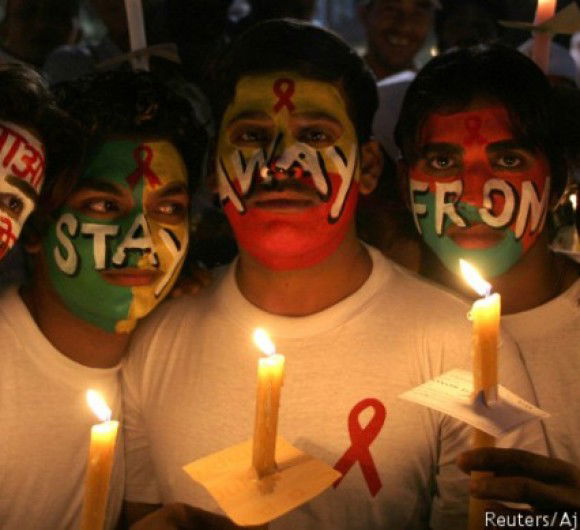Health
Men more aware about HIV/AIDS, yet more affected

Men are more likely than women to have comprehensive knowledge about HIV/AIDS; yet the disease is more prevalent among men, an analysis of government data shows.
The National Family Health Survey 2015-16 (NFHS-4) takes comprehensive knowledge to mean knowledge regarding consistent use of a condom during every sexual intercourse. Nationwide, 21 per cent of women and 32 per cent of men have comprehensive knowledge of HIV/AIDS, the survey showed.
Among other conclusions, the survey emphasised that mutually-exclusive relations with one partner can reduce one's chances of getting HIV/AIDS; a healthy-looking person can have HIV/AIDS, so using a condom is a must for every sexual encounter; and Indians must reject common misconceptions about transmission or prevention of HIV/AIDS.
Some such misconceptions include: Sharing food, cutlery, and clothes spreads AIDS; both partners have HIV, so no protection is needed; and you cannot have sex with an infected person without acquiring HIV/AIDS.
In 31 of the 35 states and Union territories (UTs) surveyed, more men display comprehensive knowledge about HIV/AIDS than women. Only in Tamil Nadu, Delhi, Puducherry and Daman and Diu was there greater awareness among women.
About 49 per cent of women in Punjab have comprehensive knowledge about HIV/AIDS, the highest among all states. The lowest figures are 9.3 per cent in Dadra and Nagar Haveli and 9.4 per cent in Assam.
Despite higher levels of awareness, men are more affected than women -- both in absolute numbers and proportionally. Of the 2.1 million HIV/AIDS affected people across India, 1.26 million (60 per cent) are men, according to National AIDS Control Organisation's (NACO) India HIV Estimations Report 2015.
The HIV prevalence rate among adults nationwide is 0.26 per cent -- 0.30 per cent for men and 0.22 per cent for women. This puts the number of HIV cases in India behind only those in South Africa and Nigeria. Yet 56 per cent of infected Indians do not get the drugs they need.
However, the trend between the sexes seems to be reversing -- infections among men declined three per cent from 1.29 million in 2012 to 1.26 million in 2015, while infections among women rose 1.38 per cent from 0.84 million to 0.85 million over the same period.
Infection rates have been on the increase among women and infants in some states, especially in rural areas, for a while. One possible explanation of this rise is migration. There are an estimated 7.2 million migrant workers in India, of whom 0.99 per cent has HIV, according to a NACO estimate. Three in four women testing positive have a husband who is a migrant labourer, according to a 2014 report by UNAIDS India.
This trend may worsen with faster migration -- 2016 reported faster rural-to-urban migration due to a collapse in rural jobs.
Barring Daman and Diu, across 35 states and UTs, more men than women are aware that consistent condom use can reduce the chances of getting HIV/AIDS. Yet, over the eight years to 2016, the use of contraceptives has declined almost 35 per cent, as abortions and consumption of emergency pills -- both accompanied with health hazards and medical side-effects -- doubled.
Social awkwardness, often induced by lack of privacy in stores, hinders condom use, a 2011 study among unmarried men from rural Madhya Pradesh showed.
A perceived link between masculinity and risky sexual behaviour also impacts condom use. Socially constructed masculinist ideals of "sexual conquest", experimentation and entitlement are major contributing factors to risky sexual behaviours which include unprotected sex and sex with multiple partners, according to a 2005 study conducted in Uttar Pradesh by University of North Carolina researchers.
However, the category "men" is heterogeneous -- it includes heterosexual and homosexual men, as well as men who have sex with men (MSM, regardless of whether they identify themselves as male or female). There are 0.43 million MSM in India, and 4.3% of them are living with HIV, according to NACO's 2015-16 annual report.
MSM, truck drivers, sex workers and injecting drug users are classified as vulnerable groups in India, although HIV/AIDS prevalence in these groups has declined over the past few years, thanks to longstanding targeted interventions focusing on behaviour change and increased condom use.
HIV prevalence rate highest in Manipur, but Andhra Pradesh reports maximum cases
At 1.15 per cent, Manipur has the highest estimated adult HIV prevalence rate, followed by Mizoram (0.8 per cent) and Nagaland (0.78 per cent). However, in absolute terms, Andhra Pradesh and Telangana have the maximum number of cases (0.39 million) of people living with HIV, followed by Maharashtra (0.3 million) and Karnataka (0.19 million).
HIV prevalence at the national level has declined from an estimated peak of 0.38 per cent in 2001-03 to 0.26 per cent in 2015, which can be attributed to large-scale implementation and high coverage of India's AIDS programme.
In October 2016, the Union cabinet approved amendments to the HIV-AIDS Bill 2014 to safeguard the rights of people living with AIDS or recently affected by HIV. According to the proposal, every HIV-positive or AIDS-affected person below the age of 18 years has the right to reside in a shared household and enjoy its facilities. The bill also prohibits any individual from publishing information or advocating feelings of hatred against HIV-positive persons and those living with them.
However, certain aspects of the bill have received criticism. For instance, it lacks clarity on whether the new bill contains provisions for free or complete treatment of patients, a longstanding concern for HIV-affected groups.
The bill only said state governments would provide HIV treatment "as far as possible" -- leaving much room for interpretation -- and patient groups have been demanding that this be changed.
(In arrangement with IndiaSpend.org, a data-driven, non-profit, public interest journalism platform. Devanik Saha is a Gender and Development student at the University of Sussex. The views expressed are those of IndiaSpend. Feedback at respond@indiaspend.org



































